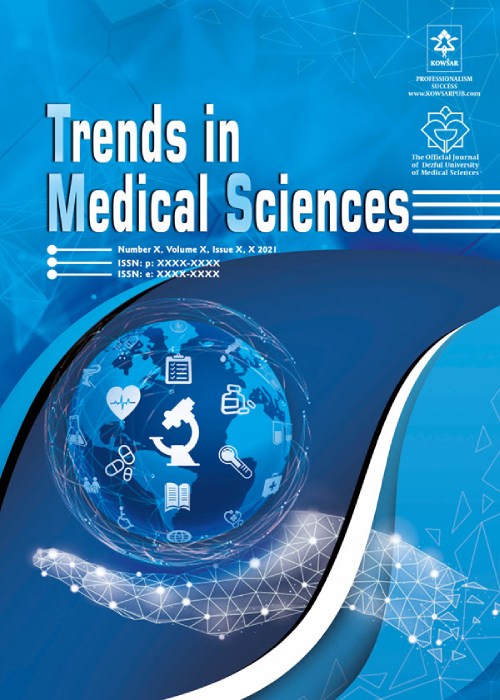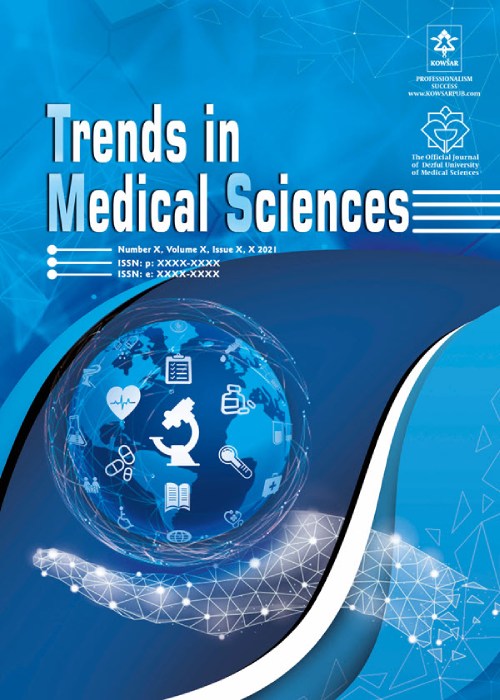فهرست مطالب

Journal of Trends in Medical Sciences
Volume:1 Issue: 1, Winter 2021
- تاریخ انتشار: 1399/12/23
- تعداد عناوین: 8
-
In Vitro Effects of Olive VegetationWater on IFN- and IL-10 Secretion in Multiple Sclerosis PatientsPage 1Background
Multiple Sclerosis (MS) is an autoimmune and inflammatory disorder of the central nervous system (CNS), which is associated with the imbalance of pro- and anti-inflammatory cytokines. Evidence indicates that nutritional interventions have some immunomodulatory impacts.
ObjectivesIn this study, we investigated the effect of olive vegetation water (OVW) on IFN- and IL-10 secretion by peripheral blood mononuclear cells (PBMCs) of MS patients.
MethodsIn this study, PBMCsof MSpatients were separated by Ficoll-Hypaque centrifugation. The cytotoxicity of OVWwas assessed by the MTT assay. The treatments were performed for 48 and 72 hours, and IFN- and IL-10 were measured by ELISA.
ResultsNo cytotoxicity was observed forOVW. Besides,OVWshowed a significant inhibitory effect on IFN- secretion but augmenting effect on IL-10 secretion by PBMCs dose-dependently.
ConclusionsThis study indicated that OVW could have immunoregulatory effects on inflammatory reactions in MS patients.
Keywords: Olive VegetationWater, Multiple Sclerosis, IL-10, IFN- -
Page 2
Nucleolin is a protein abundantly present in the nucleolus, but its expressiononthe surface of cells is potentially associated with various types of malignancies. So far, several nucleolin-targeting strategies, including the nucleolin-targeting peptide, anti-nucleolin pseudopeptides, anti-nucleolin antibodies, and the anti-nucleolin aptamer, AS1411, have been developed and investigated in different types of studies. The AS1411 aptamer has been known as the outstanding approach for targeting nucleolin with superior specificity and therapeutic potential in comparison with other targeting strategies. In this review, we highlight different nucleolintargeting strategies for the targeted delivery of chemotherapeutic drugs, proteins with therapeutic potential, and toxins.
Keywords: Nucleolin, AS1411, Aptamer, Cancer, Nanoparticles, Drug Delivery -
Page 3
Chimeric antigen receptor (CAR) T cell therapy is rapidly being established as a new cancer treatment modality especially for the treatment of hematologic malignancies. Alongside being capable of inducing durable responses in such malignancies, CAR T cell therapy has always been accompanied by exclusive toxicities such as cytokine release syndrome (CRS), that can range from mild to life-threatening. These toxicities require intensive monitoring and fast and executive management procedures to reduce the level of damages or the rate of mortality in CAR T cell therapy recipients. In this review, we tend to introduced some of the most common CAR T cell therapy-related toxicities and their clinical demonstrations. Furthermore, we also introduce some of the management procedures commonly considered in this regard.
Keywords: Chimeric Antigen Receptor, Cancer Immunotherapy, Toxicities, Clinical Management, Cytokine Release Syndrome -
Page 4
Context:
COVID-19 induces damage to the liver in addition to the pulmonary system. This event can alter hepatic biochemical and histological variables. Therefore, the present mini-review study investigated the effect of COVID-19 on hepatic damages and its cellular mechanism of action.
Evidence Acquisition:
In this mini-review study, the effects of COVID-19 on liver cells were sought in PubMed without restriction. The related components were searched in the Me SH term system and also used in two groups of COVID-19 and hepatocytes in combination with each other. Then, the titles and abstracts of the selected articles were assessed, and unrelated articles were removed.
Results and ConclusionCOVID-19 leads to liver tissue damage and hepatocyte apoptosis by inducing increased cytokines, ischemia, and hepatic hypoxia following cardiorespiratory failure, coagulation disorders, and intracellular calcium. The SARS-CoV-2 virus exerts this effect through the ACE2 receptor and increasing its expression in cholangiocytes.
Keywords: COVID-19, SARS-CoV-2, Liver, Hepatocyte -
Page 5Background
Cardiovascular disease (CVD), particularly coronary artery disease (CAD), constitutes the leading cause of death across the world. They are responsible for the highest mortality rate in Iran. The traditional risk factors for CAD are smoking, obesity, hypertension, family history, diabetes mellitus, and hyperlipidemia. Furthermore, enhanced oxidative stress is known as a novel risk factor for CAD.
ObjectivesThe associations of oxidative and antioxidative markers were investigated relative to the occurrence and severity of CAD.
MethodsAtotal of 286 participants, including 141 males and 145 females aged 30 - 70, were classified asCADcase and control groups, based on their coronary angiography results. The CAD severity scoring was done based on the number and extent of lesions in coronary arteries. The activity of superoxide dismutase (SOD), catalase (CAT), glutathione peroxidase (GPx), and Total antioxidant capacity (TAC) was assayed using the ferric reducing ability of plasma (FRAP) method. Meantime, malondialdehyde (MDA) was measured as a lipid peroxidation product.
ResultsThe results demonstrated a significant increase inSODactivity (P = 0.019) and the uric acid concentration (P = 0.000) of CAD patients compared to the control group. Although no change was seen in GPx and CAT activity, as well as FRAP and MDA, a significant positive correlation was found between CAT and SOD activity (P = 0.011) and between FRAP and uric acid (P = 0.000) levels.
ConclusionsThe results suggest that some antioxidants are significantly associated with the severity of CAD, thereby helping predict the risk of cardiovascular events. However, extra studies are needed to endorse the significance of these findings.
Keywords: Coronary Artery Disease, Enzymatic Antioxidants, Oxidative Stress -
Page 6Objectives
The etiology of Alzheimer’s disease is supposed to involve environmental exposure and genetic vulnerability. The present study aimed to assess the association between Alzheimer’s disease and its risk factors.
MethodsWe conducted a case-control study of 95 Alzheimer’s disease patients and 98 matched controls. All participants (case and control groups) were examined by mini-mental state examination. This information was collected by a risk factor questionnaire from January to June 2019. Data were analyzed using logistic regression analysis via SPSS-22 software.
ResultsThe findings revealed the effect of risk factors’ odds ratios on the occurrence of Alzheimer’s disease by logistic regression analysis. Sex (female), chronic disease, loneliness or being single, and family history showed positive associations with AD, whereas daily physical exercise, religious beliefs, high level of social communication, and male sex had negative associations with AD development (P < 0.05).
ConclusionsThe study highlighted the difficulty of etiology and recommended that the effective interventions for social support of older people, psychological condition, chronic disease, and lifestyle may be promising preventive policies.
Keywords: Alzheimer’s Disease, Environmental Risk Factors, Risk Factors -
Page 7Background
Comprehensive and reliable information about intellectual disability (ID) and its association with environmental and demographic variables is scarce.
ObjectivesThis study aimed to investigate the characteristics of intelligence quotient (IQ) in children with ID.
MethodsIn this descriptive cross-sectional study, all children with ID under the care of the welfare organization and special needs schools of the city of Rafsanjan were included in the study by census sampling (n = 207). After obtaining informed consent, parents completed a checklist including participants’ age, gender, birth month, birth season, and birth order, and also parents’ age and education level. Data were analyzed by one-way ANOVA and chi-square tests.
ResultsOut of 207 children, 107 (51.7%) were male, 100 (48.3%) were female, 36.2% were first-born, 14.5% were born in May, and 5.3% were born in March (the most-the least). The relationship of IQ to birth season and month was not significant (P > 0.05). Among the children, 39.6% were offspring of consanguineous marriages, but no significant relationship was observed between their IQ and consanguineous marriages (P > 0.05). The level of ID was correlated with parents’ age (P < 0.05). A significant relationship was also found between IQ and the number of offspring (P = 0.004). All cases of severe ID were seen in girls and a significant relationship was detected between IQ and gender (P = 0.0001).
ConclusionsIndividuals with ID have an IQ below 70. ID in children was correlated with the parents’ old age and low education level, but not with their birth season. However, given the higher prevalence of infectious diseases especially viral infections in cold months, it is only sensible to educate couples about how to protect the health of mother and fetus during these periods.
Keywords: Intellectual Disability, Intelligence, Season -
Page 8Background
Immunometabolism targeting therapy of auto-inflammatory diseases is an emerging strategy compared to immune system global suppression. However, our knowledge in this field needs promotion.
ObjectivesWe examined the effects of serum starvation stress on metabolic activity in human peripheral blood mononuclear cells (PBMCs).
MethodsFresh immune cells were isolated from four healthy adult volunteers and cultivated with or without fetal bovine serum (FBS) at various time points under standard conditions. Glucose and intra- and extracellular lactate levels were assessed using routine techniques, and 3-(4, 5 -dimethylthiazol-2-yl)-2, 5-diphenyl tetrazolium bromide (MTT) reduction assay was used to determine mitochondrial function.
ResultsSpindle shape macrophage-like cells, which appeared early, were replaced at 96 h by large round monocytes/macrophagelike cells, with more frequency in the non-starved group. Interestingly, serum starvation dictated a status, especially in monocyte/macrophage-like cells, that led to prolong decrement in mitochondrial dehydrogenase-mediated reduction of MTT. This difference was confirmed with the MTT assay quantitatively (P < 0.05). Moreover, the intra- and extracellular lactate concentrations were lower in starved cells than in non-starved controls (P < 0.05), and glucose levels were higher in 72 h starved cell culture supernatants than in non-starved control cells (P < 0.05).
ConclusionsThis study showed that under serum starvation-induced metabolic stress, lactate production is altered in immune cells, and total oxidative mitochondrial activity is reduced in macrophage-like cells. These findings open a new window to target immune cell metabolism for the treatment of autoinflammatory and autoimmune diseases.
Keywords: Metabolism, Serum, Lactate, Immune System, COVID-19


